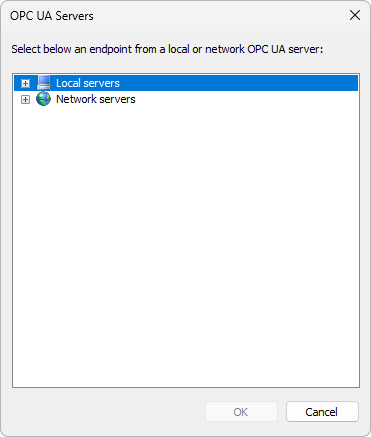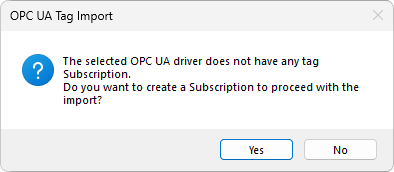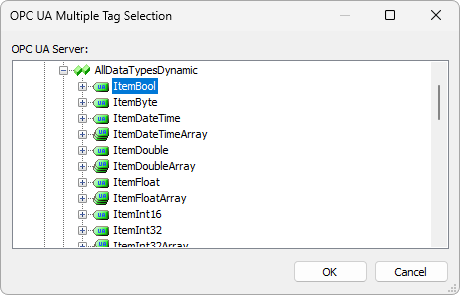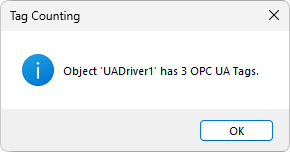To configure an OPC UA Driver, right-click this object and select the Select Server ![]() item.
item.

Select Server option
The following window is then displayed, allowing to select an OPC UA Server on a local computer or on a network.

OPC UA Servers window
For each OPC UA Server, locally or on a network, endpoints are enumerated, which can use different protocols and security modes. In addition, for each endpoint an OPC UA Server can also support different ways of identifying and authenticating users.
Currently, Elipse E3 allows a connection only using the Binary TCP mode. For this mode, Elipse E3 supports security modes defined by the OPC UA standard, with several combinations of security policies. For authentication, Elipse E3 only supports Anonymous and User and Password modes.
NOTE |
The OPC UA Servers window lists all protocols and security modes, for user information. However, only Elipse E3 compatible modes can be selected. |
When selecting an Elipse E3 compatible endpoint, the EndPointURL, SecurityMode, and SecurityPolicy properties of this object are automatically filled in.
If the UserName and Password properties of this object are left blank, Elipse E3 uses an anonymous connection with an OPC UA Server. Otherwise, Elipse E3 sends these property values to an OPC UA Server, which must support that type of authentication on the selected endpoint.
In this object users can configure several time-outs for an OPC UA connection. These time-out limits (the TimeoutCall, TimeoutConnection, and TimeoutSession properties) are always in milliseconds and they must be set according to communication performance, which may be limited by an OPC UA Server, by a network, by computers executing an OPC UA Client and an OPC UA Server, and even by operations performed on an OPC UA Client. These settings must be performed on a case-by-case basis and these property values are only suggestions.
In Elipse E3 Studio, communication with an OPC UA Driver can be activated by selecting the Activate Communication ![]() option on object's contextual menu. Activation is performed automatically by Query objects when selecting OPC UA Servers, OPC UA Tags, or when performing a visualization of Query results on the Visualize tab.
option on object's contextual menu. Activation is performed automatically by Query objects when selecting OPC UA Servers, OPC UA Tags, or when performing a visualization of Query results on the Visualize tab.
When selecting the Import Tags ![]() option, the window on the next figure is displayed, in case there is no OPC UA Subscription object configured in this OPC UA Driver.
option, the window on the next figure is displayed, in case there is no OPC UA Subscription object configured in this OPC UA Driver.

Message referring to OPC UA Tag import
Click Yes to create an OPC UA Subscription and open the window on the next figure, where users can select OPC UA Tags for importing.

OPC UA Multiple Tag Selection window
On this window, users can use the key combination CTRL + Mouse click to select non-consecutive OPC UA Tags and SHIFT + Mouse click to select a range of OPC UA Tags.
Notice that to edit OPC UA Driver properties it may be necessary to deactivate communication. If communication is active in Elipse E3 Studio, then users can open a window with information about the selected OPC UA Server by selecting the Information About Server ![]() option on object's contextual menu, shown on the next figure. In case a connection is not established, for any reason, this window displays question marks instead of OPC UA Server information.
option on object's contextual menu, shown on the next figure. In case a connection is not established, for any reason, this window displays question marks instead of OPC UA Server information.

OPC UA Server Information window
When selecting the Tag Counting ![]() option, the window on the next figure is displayed, allowing to view the number of OPC UA Tags available on an OPC UA Driver.
option, the window on the next figure is displayed, allowing to view the number of OPC UA Tags available on an OPC UA Driver.

Tag Counting window
The Update IDs for All Tags ![]() option, allows updating the OPC UA Node Identifiers (NodeIDs) of all imported OP UA Tags, by using the path indicated in OPC UA Tags' ItemID property.
option, allows updating the OPC UA Node Identifiers (NodeIDs) of all imported OP UA Tags, by using the path indicated in OPC UA Tags' ItemID property.